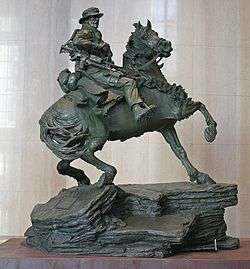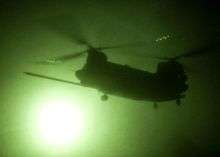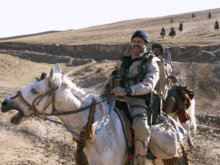America's Response Monument
 America's Response Monument | |
| Artist | Douwe Blumberg |
|---|---|
| Year | 2011 |
| Type | Bronze |
| Dimensions | 400 cm × 210 cm × 400 cm (13 ft × 7 ft × 13 ft) |
| Location | One World Trade Center, New York City |
America's Response Monument, subtitled De Oppresso Liber, is a life-and-a-half scale bronze statue in front of One World Trade Center, across from the National September 11 Memorial in New York City. Unofficially known as the Horse Soldier Statue, it is the first publicly accessible monument[1] dedicated to the United States Special Forces.
The statue was conceived by sculptor Douwe Blumberg and commissioned by an anonymous group of Wall Street bankers who lost friends in the 9/11 attacks. It was dedicated on November 11, 2011 in a ceremony led by Vice President Joe Biden and Lt. Gen. John Mulholland, commander of U.S. Army Special Operations Command.
The statue commemorates the servicemen and women of America’s Special Operations response to 9/11, including those who fought in the early days of Operation Enduring Freedom. This operation led to the initial defeat of the Taliban in Afghanistan.
Background

The artist, sculptor Douwe Blumberg, had been a horse trainer for 18 years and is a military history buff. He has completed more than 200 private and public commissions and has received numerous awards.[4] He was inspired to begin the sculpture by a photo that Defense Secretary Donald Rumsfeld displayed at a press conference shortly after U.S. forces entered Afghanistan.[2] As part of Operation Enduring Freedom, President George W. Bush sent covert forces into Afghanistan to help the Northern Alliance defeat the Taliban. The group, named Task Force Dagger, was a joint Special Operations team consisting of Green Berets from the 5th Special Forces Group, aircrew members from the 160th Special Operations Aviation Regiment ("Nightstalkers"), and Air Force Combat Controllers.
Flight into Afghanistan
The 12-man Operational Detachment Alpha (ODA) 595 team, along with two Air Force combat controllers, were the second group of Task Force Dagger to enter Afghanistan. In the first operation of its kind, they were flown from a former Soviet airbase, now named the Karshi-Khanabad Air Base, in Uzbekistan[5] more than 300 kilometers (190 mi) across the 16,000 feet (4,900 m) Hindu Kush mountains in zero-visibility conditions by a SOAR MH-47E Chinook helicopter. They were dropped onto a farmer's field at 0200 on October 19, 2001,[6] about 80 km (50 mi) south of Mazar-i-Sharif in the Dari-a-Souf Valley, south of Mazar-e-Sharif. The team arrived only 39 days after the Al-Qaeda attack on the World Trade Center for what they thought would be a year-long stay.[5] They linked up with the Northern Alliance led by General Dostum.
Horseback transportation
Once they arrived in-country, they needed transportation suitable to the difficult mountainous terrain of Northern Afghanistan. The men were offered horses by the Afghan tribes they were supporting, and although only two men had any significant experience on horseback, they readily accepted.[7]
Capt. Will Summers, Special Forces team leader, said "It was as if The Jetsons had met The Flintstones."[7] The mostly inexperienced riders soon requested replacements for the traditional small, hard, wooden saddles used by the Afghanistan soldiers. A supply of lightweight, Australian-style saddles was air-dropped in mid-November.[6] The last U.S. Army unit to receive horseback training was the 28th Cavalry in 1943.[8]
Initial attack against Taliban
On October 21, the Northern Alliance led by General Dostum prepared to attack the fortified village of Bishqab, defended by several T-54/55 tanks, a number of BMPs (armored personnel carriers) armed with cannons and machine guns, and several ZSU-23 anti-aircraft artillery. The Northern Alliance totaled about 1,500 cavalry and 1,500 light infantry. They were assisted by the 12-member U.S. Special Forces team and American air power. To reach the enemy, they crossed a mile-wide open plain cut by seven ridges that would leave them completely exposed to enemy fire. To the U.S. Special Forces, it looked like the Charge of the Light Brigade, Battle of Fredericksburg, and Pickett's Charge at Gettysburg, all at the same time.[9] Supported by American air power and precision-guided munitions, they successfully attacked the Taliban, many of whom threw away their weapons and ran.
The next day, the Northern Alliance prepared to attack Cobaki. The U.S. Special Ops teams used SOFLAM Laser Target Designators to identify targets for air strikes on the enemy armor and artillery. The Northern Alliance followed this with a horse cavalry charge. When it looked like Dostum’s cavalry charge would fail, several members of ODA 595 rode into action and helped win the battle.[9] "It was like out of the Old Testament," commented Lt. Col. Max Bowers, former commander of three Special Forces horseback teams. "You expected Cecil B. DeMille to be filming and Charlton Heston to walk out."[10][11][12]
Soldier photo

Defense Secretary Donald Rumsfeld displayed a photo of Staff Sgt. Bart Decker on an Afghan horse during a news conference on November 15, 2001. When sculptor Blumberg saw that image, he felt impressed that he had to do something.[11] “The visual irony of a 21st-century, high-tech trooper mounted on a ragged Afghan mountain horse, unchanged for centuries, fascinated me.”[13] Despite the array of high-tech military gear they carried into battle, it was the trusty Afghanistan stallions that were essential to the campaign's success. The mounted US troops became known as the "horse soldiers".[14]
World Trade Center steel
During the battle against the Taliban, each Green Beret A-Team carried with them a piece of steel recovered from the rubble of the World Trade Center in honor of the 9/11 victims.[4] Later during the war, they each buried their piece of steel at a significant point in the battle. Bowers chose Mazar-i-Sharif as the location to bury his piece of the World Trade Center. This was the location of one of their toughest battles and where CIA officer Mike Spann became the first American killed in action in Afghanistan.[4]
Like the soldiers it honors, the statue carries a piece of steel from the World Trade Center. It is visible under the plinth, embedded in the base.[15] The monument's inscription states that the steel "symbolizes the connection between the events of 9/11 and the actions of the special operations heroes this monument honors."
Description
The life-and-a-half scale[16] statue commemorates the actions of the servicemen and women of America’s Special Operations who responded to the 9/11 attacks, including the Special Operations forces who fought in the early stages of Operation Enduring Freedom. The base bears the sculpture's title, “America’s Response Monument.” The statue is sub-titled De Oppresso Liber, which is Latin for ‘to liberate the oppressed’, the motto of the Green Berets.[17]
After committing to build the statue, Blumberg was invited to Fort Campbell, where he met veterans of Task Force Dagger. He learned that his depiction of the Green Beret wasn't at all accurate. Blumberg invited them to his studio where they worked closely with him to be sure he got the horse and soldier precisely correct.[16] Blumberg took six weeks to re-sculpt the piece until he was sure it was accurate in every detail. It depicts a Special Forces Green Beret on horseback leading the invasion into Afghanistan. He is holding field glasses in one hand. An M4 with an attached grenade launcher is slung under his shoulder. An outline of a wedding band is visible under the glove of the soldier's left hand. Blumberg said, “That’s my way of tipping my hat to wives, marriages and strain on families. It’s to acknowledge the stresses caused by multiple deployments.”[13] Blumberg created the sculpture's face without using a model or photos. It does not represent the face of a specific individual.[18]
The small, Afghan “Lokai” horse shows “Tersk” breeding, indicating a horse of Eastern European heritage descended from horses brought in by the Soviets in the 1980s. In the Afghan culture, the soldiers only ride stallions into battle.[16] The horses could be difficult to control, and the statue depicts the horse rearing back. The horse tack depicted by Blumberg is traditional to the Aghani people. A tasseled breast collar helps keep the flies off the chest and legs.[16] The statue’s base reflects the steep, precipitous slopes the soldiers often traveled on horseback.[15]
Production
When Blumberg saw the photo of the modern soldiers on horseback displayed by Defense Secretary Donald Rumsfeld in late 2001, he felt moved to create a statue marking the singular event. Taking the initiative and at his own expense, he took nine months to complete an 18 inches (460 mm) tall bronze sculpture of a Green Beret riding an Afghan horse.[19] His work came to the attention of presented his work to the John F. Kennedy Special Warfare Museum, the regimental museum for the U.S. Army Special Forces at Fort Bragg.[9]
From there, word-of-mouth spread. In 2003, the non-profit Foundation for US Historical Monuments was formed to help bring about the monument's creation.[16] After their efforts faltered, an anonymous group of Wall Street bankers who lost friends and co-workers in the 9/11 attacks[13] learned about his sculpture. They commissioned Blumberg to build a large-scale version for a monument near Ground Zero, paying $500,000 for the work.[20] The Gary Sinese Foundation[21] and the Green Beret Foundation[22] supported the effort to build the monument. No public funds were used. Two of the individual Wall Street supporters said they were asked by families and friends if there was a place that individuals could go to remember the U.S. troops overseas who daily combat potential terrorist threats. "We wanted to do something for the special operations community and all military service branches, because every day since 9/11, we've had to look at that hole in the ground," one of the private backers says. "What everyone needs to know is: There are people out there like this team, like the Green Berets, that are willing to sacrifice at all costs for them."[13] At its rededication, the statue's entire cost of over $750,000 was paid by hundreds of private citizens.[23]
Blumberg lives in DeMossville, Kentucky. However, much of the work on the bronze monument was done by The Crucible Foundry in Norman, Oklahoma, a full-service foundry specializing in monumental bronze.[4] The 5,000 pounds (2,300 kg) bronze statue is 13 feet (4.0 m) tall and is mounted on a 3 feet (0.91 m) tall granite plinth. "This job is something I'm emotional about," Blumberg said. "This allows me to honor soldiers, capture a unique aspect of their service and then have the opportunity to put it in New York. I couldn't have scripted it better. This is super powerful for me."[24]
Dedication
The statue was introduced to the public during the Veteran's Day Parade in New York City on November 11, 2011. The statue was displayed on a float which traveled from Fifth Ave at 23d and north to Fifth Ave at 56th.[15] It was dedicated the same day in a ceremony led by Vice President Joe Biden and Lt. Gen. John Mulholland, commander of Special Operations Command and formerly commander of Task Force Dagger during the initial days of the War in Afghanistan.[7][25] It was temporarily located in the West Street Lobby inside One World Financial Center in New York City opposite Ground Zero.
It is the first publicly accessible monument to United States special forces.[26][1] The The Special Warfare Memorial Statue, commemorating the actions of Green Beret forces in the Vietnam War, was placed on Meadows Memorial Field at Fort Bragg, North Carolina on November 19, 1969, but all visitors must pass through base security.[27][28] The land at One World Trade Center for the monument was donated by a private Wall Street firm.[7]
The statue was rededicated on October 19, 2012 by General John Mulholland. At the time of the original battle he was Lieutenant general and Deputy Commanding General of U.S. Army Special Forces Command. He dedicated the statue in its new location in front of One World Trade Center across from Ground Zero and 9/11 Memorial. The bronze statue was positioned so the soldier atop the horse is keeping a watchful eye as he looks back over his shoulder at the World Trade Center and its tenants. Soldiers representing the United States Army Special Operations Command attended the ceremony.[25]
On September 13, 2016, the statue was rededicated once again at a permanent site on an elevated space on the south side of Ground Zero in Liberty Park, a 1 acre (0.40 ha) park in Lower Manhattan. The park was built on top of a vehicle security center and overlooks the memorial to the September 11, 2001 victims.[29][30]
In popular culture
In 2009, Disney bought the movie rights to Doug Stanton's book Horse Soldiers and Jerry Bruckheimer began seeking financing in December 2011. Nicolai Fuglsig was attached as the director, but Disney dropped the project to focus on more family-friendly projects.[31]
References
- 1 2 Forester, Thad (October 11, 2013). My Brother in Arms: The Exceptional Life of Mark Andrew Forester, United States Air Force Combat Controller. Cross-D Enterprises. p. 311. ISBN 978-0984603534. Retrieved 8 February 2016.
- 1 2 "Our Man on the Horse". The Cluster Project. Retrieved 13 September 2016.
- ↑ "US Special Forces Avenged 9-11 on Horseback". Archived from the original on February 17, 2016. Retrieved 13 September 2016.
- 1 2 3 4 "The Horse Soldiers: the Story Behind the Statue". November 14, 2011. Retrieved 12 January 2012.
- 1 2 "Task Force Dagger – Operation Enduring Freedom". Retrieved 13 January 2012. page 127ff
- 1 2 Briscoe, Charles H.; Kiper, Richard L.; Schroder, James A.; Sepp, Kalev I. (2003). Weapon of Choice: U.S. Army Special Operations Forces in Afghanistan. Fort Leavenworth, Kansas: Combat studies institute Press. ISBN 978-0-16-072958-4.
- 1 2 3 4 Bissell, Brandon (18 November 2011). "'Horse Soldier' statue dedicated near Ground Zero". Retrieved 12 January 2012.
- ↑ "The 28th Cavalry: The U.S. Army's Last Horse Cavalry Regiment". Lawton, OK: 9th and 10th (Horse) Cavalry Association. Archived from the original on December 20, 2007. Retrieved January 16, 2012.
- 1 2 3 Zimmerman, Dwight Jon (September 16, 2011). "Operation Enduring Freedom: The First 49 Days". Retrieved 15 January 2012.
- ↑ "Jawbreaker – CIA Special Activities Division". Retrieved 11 September 2015.
- 1 2 Quade, Alex (October 6, 2011). "Monument honors U.S. 'horse soldiers' who invaded Afghanistan". CNN. Retrieved 12 January 2012.
- ↑ Quade, Alex (October 15, 2011). "The Horse Soldiers of 9/11". Dailycaller.
- 1 2 3 4 Quade, Alex (October 27, 2011). "Commando monument near ground zero unveiled on Veterans Day". Washington Times. Retrieved 12 January 2012.
- ↑ ""Horse Soldier" statue stands proud near Ground Zero". Retrieved 12 January 2012.
- 1 2 3 ""De Oppresso Liber" Statue Finds Home at Ground Zero". November 11, 2011. Retrieved 12 January 2012.
- 1 2 3 4 5 "Artist's Statement". Foundation for U.S. Historical Monuments. Archived from the original on April 1, 2008. Retrieved 16 January 2012.
- ↑ "De Oppresso Liber-Green Beret Motto". November 22, 2011. Retrieved 14 January 2012.
- ↑ Altman, Howard (March 5, 2015). "Who was the model for horse soldier statue? Claim stirs controversy". Retrieved 8 February 2016.
- ↑ "Unconventional Work". Blackwater. Retrieved 13 January 2012.
- ↑ "Secret mission: The Horse Soldiers of 9/11". Retrieved 12 January 2012.
- ↑ Quade, 01/06 by: Alex (January 2011). "2012 Resolution: Valuing Something Greater Than Self". Gary Sinise Foundation. Retrieved 15 January 2012.
- ↑ "Report: Veterans Day, 2011". November 12, 2011. Retrieved 12 January 2012.
- ↑ White, Bill (18 October 2012). "Ground Zero salute to American heroes". New York Post. Retrieved 18 March 2013.
- ↑ Painter, Bryan. "Monument honoring troops on horseback has Norman ties". Retrieved 12 January 2012.
- 1 2 Ospina, Barbara. "America's Response Statue placed to provide overwatch on One World Trade Center". United States Army. Retrieved 18 March 2013.
- ↑ "The Horse Soldier Statue Charitable Drawing". February 23, 2013. Retrieved 7 February 2016.
- ↑ Howlett, D. Roger, ‘’The Sculpture of Donald De Lue: Gods, Prophets, and Heroes’’, David R. Godine, Publisher, Boston 1990 p. 143
- ↑ "New commander takes helm of 3rd Special Forces Group (Airborne)". Retrieved 13 March 2013.
- ↑ Lipsky, Seth (September 12, 2016). "Two new NYC statues are mute reminders of war". New York Post. Retrieved 19 September 2016.
- ↑ "Elevated park at WTC site, overlooks 9/11 memorial". Post Register. July 2, 2016. Retrieved 19 September 2016.
- ↑ Chitwood, John. "Jerry Bruckheimer Shopping Afghanistan War Story HORSE SOLDIERS". Retrieved 8 February 2016.
Further reading
- Stanton, Doug (2009). Horse Soldiers: The Extraordinary Story of a Band of US Soldiers Who Rode to Victory in Afghanistan (First Scribner hardcover ed.). New York: Scribner. ISBN 978-1-4165-8051-5.
Coordinates: 40°42′46.8″N 74°0′48.6″W / 40.713000°N 74.013500°W
